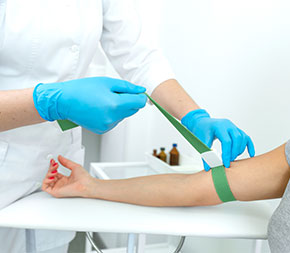How Northeast Medical Institute - New Haven Campus Phlebotomy Course & Cna Class can Save You Time, Stress, and Money.
How Northeast Medical Institute - New Haven Campus Phlebotomy Course & Cna Class can Save You Time, Stress, and Money.
Blog Article
The Definitive Guide for Northeast Medical Institute - New Haven Campus Phlebotomy Course & Cna Class
Table of ContentsNot known Facts About Northeast Medical Institute - New Haven Campus Phlebotomy Course & Cna ClassTop Guidelines Of Northeast Medical Institute - New Haven Campus Phlebotomy Course & Cna ClassThe Buzz on Northeast Medical Institute - New Haven Campus Phlebotomy Course & Cna ClassOur Northeast Medical Institute - New Haven Campus Phlebotomy Course & Cna Class StatementsThe Best Strategy To Use For Northeast Medical Institute - New Haven Campus Phlebotomy Course & Cna Class8 Simple Techniques For Northeast Medical Institute - New Haven Campus Phlebotomy Course & Cna Class
The use of such gadgets ought to be come with by various other infection prevention and control methods, and training in their usage. Not all safety tools are suitable to phlebotomy. Before picking a safety-engineered gadget, users ought to thoroughly examine available devices to determine their appropriate use, compatibility with existing phlebotomy methods, and effectiveness in shielding team and people (12, 33).For setups with reduced resources, cost is a driving factor in procurement of safety-engineered gadgets. Where safety-engineered tools are not available, experienced usage of a needle and syringe is appropriate.
labelling); transportation problems; interpretation of results for professional administration. In an outpatient division or center, provide a dedicated phlebotomy work area containing: a clean surface area with two chairs (one for the phlebotomist and the other for the person); a hand clean basin with soap, running water and paper towels; alcohol hand rub. In the blood-sampling area for an outpatient division or clinic, offer a comfy reclining couch with an arm remainder.
The Basic Principles Of Northeast Medical Institute - New Haven Campus Phlebotomy Course & Cna Class
Make sure that the signs for blood tasting are clearly specified, either in a composed protocol or in documented guidelines (e.g. in a research laboratory form). In any way times, comply with the approaches for infection prevention and control provided in Table 2.2. Infection avoidance and control practices. Gather all the tools required for the procedure and area it within risk-free and easy reach on a tray or trolley, making certain that all the items are clearly visible.
Where the individual is grown-up and mindful, comply with the actions detailed below. Introduce yourself to the patient, and ask the person to state their full name. Check that the laboratory kind matches the patient's identity (i.e. match the patient's details with the lab type, to make certain precise identification). Ask whether the license has allergies, fears or has ever before passed out during previous shots or blood attracts.
Make the client comfy in a supine placement (when possible). Place a clean paper or towel under the individual's arm. Talk about the test to be done (see Annex F) and get verbal approval. The patient has a right to decline a test at any moment prior to the blood sampling, so it is important to make certain that the patient has comprehended the treatment.
The Ultimate Guide To Northeast Medical Institute - New Haven Campus Phlebotomy Course & Cna Class
Prolong the client's arm and inspect the antecubital fossa or lower arm. Situate a vein of a good dimension that is noticeable, straight and clear. The diagram in Section 2.3, shows typical positions of the vessels, yet lots of variants are possible. The mean cubital blood vessel exists in between muscular tissues and is normally the most easy to puncture.
DO NOT place the needle where blood vessels are diverting, due to the fact that this enhances the possibility of a haematoma. Situating the vein will certainly help in establishing the correct dimension of needle.
Specimens from main lines carry a risk of contamination or incorrect research laboratory examination results. article It is acceptable, yet not suitable, to draw blood specimens when first presenting an in-dwelling venous tool, prior to linking the cannula to the intravenous fluids.
The Buzz on Northeast Medical Institute - New Haven Campus Phlebotomy Course & Cna Class
Permit the area to dry. Failing to enable sufficient contact time raises the danger of contamination. DO NOT touch the cleaned site; specifically, DO NOT put a finger over the vein to lead the shaft of the revealed needle. It the website is touched, repeat the sanitation. Carry out venepuncture as complies with.
Ask the person to form a fist so the blood vessels are extra prominent. Get in the vein promptly at a 30 level angle or less, and continue to introduce the needle along the vein at the simplest angle of entry - PCT Courses. When enough blood has been accumulated, launch the tourniquet BEFORE withdrawing the needle
Indicators on Northeast Medical Institute - New Haven Campus Phlebotomy Course & Cna Class You Should Know
Take out the needle delicately and use mild stress to the site with a clean gauze or completely dry cotton-wool round. Ask the person to hold the gauze or cotton woollen in location, with the arm prolonged and raised. Ask the person NOT to flex the arm, because doing so creates a haematoma.

3 Easy Facts About Northeast Medical Institute - New Haven Campus Phlebotomy Course & Cna Class Described
Do not push the syringe plunger since added stress increases the threat of haemolysis. Where possible, keep televisions in a shelf and relocate the shelf towards you. Inject downwards right into the proper coloured stopper. DO NOT remove the stopper because it will certainly launch the vacuum cleaner. If the example tube does not have a rubber stopper, inject exceptionally slowly right into the tube as decreasing the pressure and rate made use of to move the sampling minimizes the risk of haemolysis.

Report this page